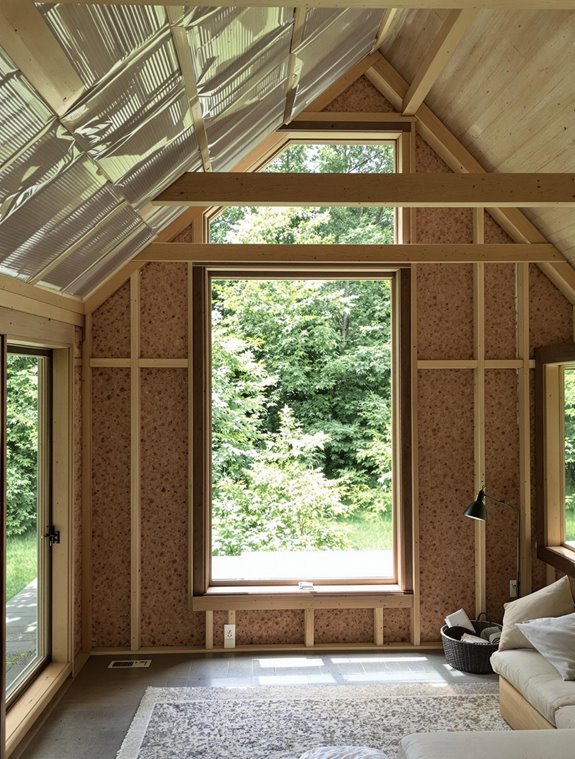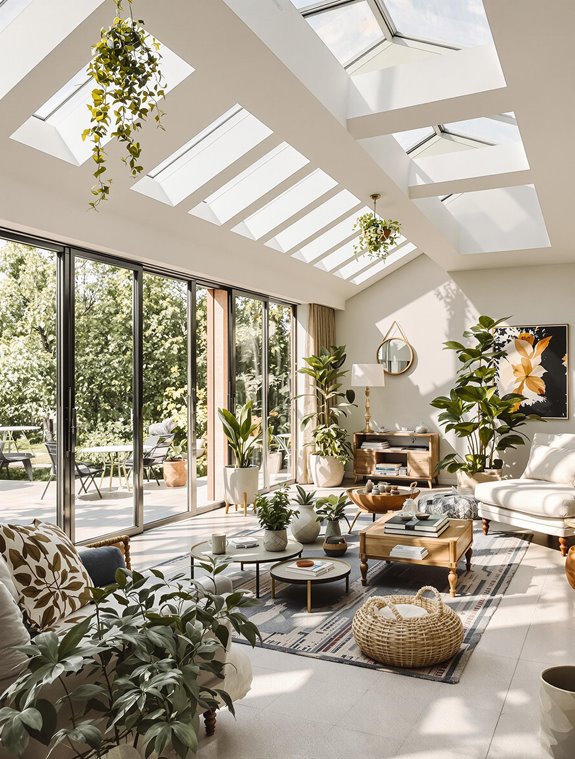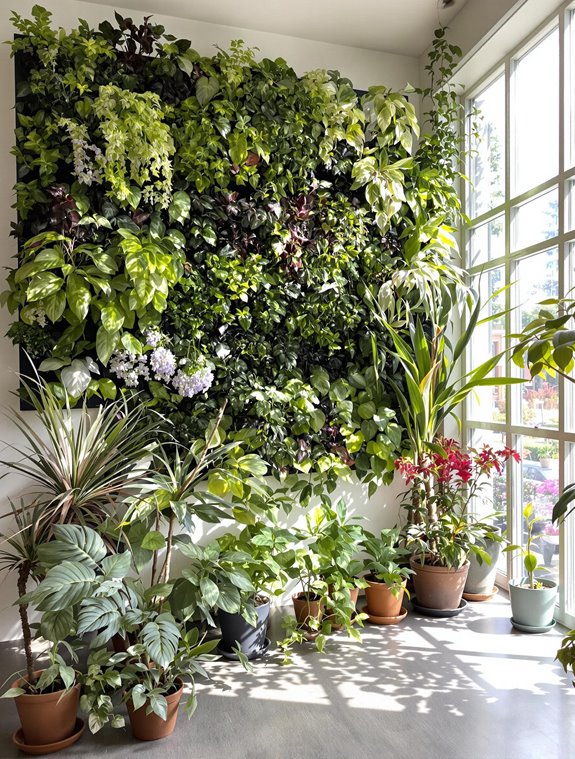Sustainable home design is like giving Mother Nature a warm hug while creating your dream space. Think bamboo floors that are stylish and guilt-free, or skylights that flood your home with sunlight—hello, mood booster! Insulating with sheep's wool may sound quirky, but trust me, it works wonders. And don't forget those rainwater systems; they'll make you the envy of your neighbor, who's still using a garden hose. With a sprinkle of energy-efficient appliances and drought-resistant landscaping, you're on your way to saving the planet, one cozy room at a time. Stick around; there's so much more to explore!
Briefly keys
- Utilize sustainable building materials like bamboo, recycled steel, and reclaimed wood to reduce environmental impact and enhance aesthetics.
- Implement energy-efficient appliances and smart home technology to lower energy consumption and promote sustainability.
- Enhance insulation and air sealing with eco-friendly materials to optimize comfort and reduce energy bills.
- Incorporate water conservation systems, such as rainwater harvesting and greywater recycling, to minimize water use and costs.
- Design with natural elements and indoor greenery to promote well-being and connect occupants with nature.
Building Materials and Construction

Sustainability in home design hinges on the careful selection of building materials and construction techniques that minimize environmental impact while maximizing efficiency. Among the stars of this eco-friendly lineup is bamboo, renowned for its rapid growth and impressive strength. Not only does it absorb more CO2 than many trees, but it also offers a lightweight alternative that can make your home feel like a cozy treehouse, minus the splinters. Additionally, its fast-growing nature means that bamboo can be harvested in just 3-5 years, making it a highly renewable resource.
Recycled materials are another hero in this narrative, transforming what could be waste into building treasures. Think of recycled steel, which, like a superhero, can be reused endlessly without losing its strength, standing tall against the elements.
Then there's reclaimed wood, which whispers stories of its past while providing that warm, rustic charm we all adore.
Innovative techniques such as straw bale construction and rammed earth also play an essential role, effortlessly blending sustainability with durability. Picture your walls wrapped in straw, offering insulation so cozy you'd think they were made for hibernation.
The marriage of these materials and techniques not only fosters a healthier planet but also creates homes that tell their own unique stories, one beam and brick at a time.
Energy Efficiency Solutions
In today's world, achieving energy efficiency in home design is vital for reducing overall energy consumption and minimizing environmental impact. Implementing energy-efficient appliances with ENERGY STAR ratings not only cuts down your bills but also showcases your commitment to sustainability.
Imagine this: a smart home where devices learn your habits and adjust accordingly, thanks to smart meters that monitor your consumption in real-time. It's like having a personal energy coach—without the sweat!
Lighting plays a pivotal role too. LED bulbs are the shining stars (pun intended) of energy efficiency, while motion sensors guarantee you never leave the lights on during that "quick trip" to the kitchen. Additionally, utilizing high-performing HVAC systems ensures optimal energy use, as they account for 42% of a home's energy consumption.
And let's not forget the beauty of natural daylight—strategically placed windows and skylights can transform spaces into sunlit sanctuaries, reducing reliance on artificial light.
To further enhance your energy strategy, consider conducting regular energy audits. These assessments can pinpoint where you might be losing energy, like that pesky draft from an ill-fitted window.
Insulation and Air Sealing

Proper insulation and effective air sealing are essential components of sustainable home design, as they markedly enhance energy efficiency and indoor comfort. Envision it: you wouldn't want your cozy living room to feel like a drafty old barn, would you?
Enter eco-friendly insulation materials such as cork, cellulose, and sheep's wool. These heroes of home comfort not only keep your space snug but also work wonders for the planet. Cork, for instance, is harvested sustainably and acts like a carbon-loving sponge, while cellulose insulation boasts a staggering 75-85% recycled content. Furthermore, choosing eco-friendly materials like Rmax polyiso insulation can significantly reduce your home's energy demand.
Now, let's not forget the importance of air sealing techniques. Visualize sealing those sneaky cracks around windows and doors, preventing your precious warm air from escaping. A little caulking can go a long way!
Advanced methods like closed-cell spray foam can fill even the tiniest gaps, ensuring your insulation does its job efficiently. With the right combination of insulation materials and air sealing, you can create an energy-efficient sanctuary that's as kind to your wallet as it is to Mother Earth.
Water Conservation Techniques
Water conservation techniques are critical for enhancing the sustainability of any home, helping to reduce water waste and promote efficient usage.
One effective method includes installing rainwater systems, which capture precious rainfall for non-potable uses like watering gardens or flushing toilets. Envision the joy of using that rainwater to nourish a thriving garden, all while lowering your water bill!
Another innovative approach is greywater recycling. This involves reusing water from sinks, showers, and washing machines, which can be filtered and redirected for irrigation or toilet flushing. Just think about the satisfaction of recycling water that's already made its rounds in your home!
Moreover, investing in efficient fixtures such as low-flow faucets and dual-flush toilets can greatly diminish water consumption. Combine these with water-saving appliances, and you'll be dancing in the rain of savings! Low-flow fixtures can significantly reduce household water usage while maintaining comfort and convenience.
Lastly, consider drought-resistant landscaping, which not only beautifies your space but also minimizes outdoor irrigation needs. By employing mulch and permeable materials, you'll foster a lush environment with far less water.
Ventilation and Natural Lighting

Effective ventilation and natural lighting are essential components of sustainable home design, greatly enhancing indoor air quality and reducing energy consumption.
Envision a home where fresh air flows freely, a delightful interplay of natural airflow that keeps you cool without cranking up the AC. Utilizing natural ventilation strategies like strategic window placement and the stack effect, you can harness the wind's gentle caress to reduce indoor heat buildup. Incorporating solar-powered ventilation systems can further enhance this natural airflow, especially on hot days.
Pair this with the wonders of daylighting strategies, and you've got a recipe for both beauty and efficiency. Large, well-placed windows invite sunlight to dance across your living spaces, banishing the dreariness of artificial lighting. Not only does this elevate your mood, but it also slashes your electricity bill.
For those sunny days, solar-powered ventilation systems can work their magic, drawing on the sun's energy to keep your home breezy. While they may come with a hefty price tag initially, consider it as an investment—your future self will thank you when those energy bills come rolling in.
Sustainable design isn't just about being eco-friendly; it's about creating a sanctuary that feels alive with nature's gifts.
Sustainable Design Orientation
Incorporating sustainable design orientation is essential for maximizing the environmental performance of a home. By thoughtfully positioning a residence, we can harness the sun's energy, reducing our dependence on artificial heating and cooling—imagine it as giving Mother Nature a high-five!
Solar gain should be optimized, particularly in colder months, by orienting living areas to face south, basking in that warm sunlight. Conversely, in the sizzling summer, we want to dodge those rays like an Olympic athlete.
Utilizing passive design techniques allows homes to regulate temperature naturally. Envision this: thick walls made of materials with high thermal mass, soaking up the sun's warmth during the day and releasing it at night, transforming your living space into a cozy retreat. Incorporating natural features into the design can further enhance passive energy benefits.
Seasonal shading, perhaps from strategically placed deciduous trees, can also provide a welcome reprieve during hotter months.
But don't forget about the topography! Working with the land—whether it's a gentle slope or a towering tree line—can enhance your home's solar orientation while preserving the natural beauty around you.
Incorporating Green Spaces

Integrating green spaces within a home is essential for enhancing both environmental sustainability and the well-being of its occupants. Envision entering your living room, greeted not just by walls, but by lively indoor gardens that breathe life into your space.
These verdant havens improve air quality, regulate humidity, and even offer up fresh herbs for your culinary masterpieces—because who doesn't want to pluck a basil leaf right off the plant? Additionally, the incorporation of indoor gardens can significantly enhance your home's overall indoor environmental quality.
Adding green walls can transform your abode into a serene retreat while regulating temperature and reducing energy costs. Biophilic design, which cleverly integrates natural elements, guarantees that you remain connected to the great outdoors, even while indoors.
Picture the sunlight streaming through wide windows, dancing on leaves, and lifting your spirits.
Now, let's not forget about plant maintenance—essential for keeping your green friends happy. Consider smart irrigation systems and modular designs that adapt to your whims.
After all, if your plants could talk, they'd appreciate a little care and attention, perhaps even a melodious serenade. So, why not welcome these green spaces and let your home flourish as a sanctuary for both you and the environment?
People are Asking
What Are the Costs Associated With Sustainable Home Design?
The costs associated with sustainable home design encompass initial investment and material costs, which can vary considerably. Key expenses include construction, energy-efficient upgrades, and labor, ultimately yielding long-term savings and enhanced indoor environmental quality.
How Can I Find Eco-Friendly Contractors?
To find eco-friendly contractors, explore their green certifications, such as LEED and Energy Star. For instance, Contractor X, lauded for its innovative designs, garnered stellar contractor reviews, reflecting its commitment to sustainable practices and client satisfaction.
What Are the Long-Term Benefits of Sustainable Homes?
The long-term benefits of sustainable homes include significant energy savings, a reduced environmental impact through efficient resource use, and enhanced property value, ultimately leading to healthier living conditions and lower long-term maintenance costs.
How Do I Maintain Energy-Efficient Systems?
Conducting regular energy audits reveals potential inefficiencies, prompting timely system upgrades. For instance, a family upgraded their HVAC after an audit, reducing energy bills by 30% and enhancing overall comfort through improved maintenance practices.
Are There Government Incentives for Sustainable Home Building?
Yes, government incentives for sustainable home building include tax credits such as the 45L Tax Credit and energy rebates for energy-efficient installations. These programs encourage environmentally friendly construction and help reduce overall costs for homeowners.
Wrapping up
Sustainable home design embodies a harmonious blend of nature's elements and modern innovation, akin to a symphony where each note contributes to a greater whole. By embracing eco-friendly practices—from energy-efficient solutions to water conservation techniques—residences can flourish as sanctuaries of sustainability. Ultimately, these thoughtful choices not only enhance the quality of life but also guarantee the preservation of the environment for future generations, creating a legacy that resonates like a gentle breeze through a flourishing forest.




